
+- WildFact (https://wildfact.com/forum)
+-- Forum: Information Section (https://wildfact.com/forum/forum-information-section)
+--- Forum: Extinct Animals (https://wildfact.com/forum/forum-extinct-animals)
+---- Forum: Pleistocene Big Cats (https://wildfact.com/forum/forum-pleistocene-big-cats)
+---- Thread: Freak Felids - A Discussion of History's Largest Felines (/topic-freak-felids-a-discussion-of-history-s-largest-felines)
RE: Freak Felids - A Discussion of History's Largest Felines - Pckts - 12-05-2015
I wonder if their adaptions also could dictate their fur and skin color?
Do they think there is a difference between fur color between them?
RE: Freak Felids - A Discussion of History's Largest Felines - GrizzlyClaws - 12-05-2015
The Fatalis lived in the open plain mixed with the scrubland, so they may have developed some kind of spots or stripes.
The Populator on the other hand may have no spot or stripe, but tawny yellow like the modern African lions which should match their camouflage corresponding to the living environment.
RE: Freak Felids - A Discussion of History's Largest Felines - tigerluver - 12-05-2015
The cursoriality and locomotion topic is a bit convoluted. One can pick one trait of an organism and attribute it to a certain locomotion and sound accurate, but then another similar trait of another organism results in a completely different, unexpected behavior and things stop making much sense.
The extremely sloped back of S. populator and somewhat sloped back of S. fatalis do not seem favorable to much high intensity running in my head, it just seems a bit off balance. Having proportionately longer proximal long bones (humerus, femur, the bone more associated with mass of the body's core) than distal long bones also makes the much running or sprinting less likely, as to be a runner or a sprinter, you'd want more ulna/tibia (the light bones which increase stride), than femur/humerus. Spoor (1986) attributes sloped backs to the assignment of the center of mass, where "In hyenas it is situated more cranial than in other large carnivores due to the heavy musculature of the fore limb, the long neck and the powerful jaws." S. populator has the first two characteristics of the hyena. Maybe it used the frontal center of mass in pinning down prey better, reducing risk to its canines.
RE: Freak Felids - A Discussion of History's Largest Felines - GrizzlyClaws - 12-05-2015
The S. populator is somewhat less of a runner than the S. fatalis, but a much stronger grappler for sure with those significant longer forearms as the purpose.
RE: Freak Felids - A Discussion of History's Largest Felines - GrizzlyClaws - 12-05-2015
@tigerluver, only some hypothesis, merely some suggestion, but without the hardcore evidence.
I tend to think that the earlier Pleistocene lions were initially the real lions, but with over million years of genetic isolation, the later Pleistocene lions should be considered as a distinct species.
The same instance we have seen with the Clouded leopard and the Sunda Clouded leopard which are two distinct species of the Clouded leopard due over million years of genetic isolation from each other.
Panthera spelaea and Panthera atrox were all daughter or grand-daughter species of Panthera (leo) fossilis. Panthera atrox in this case was morphologically more archaic than Panthera spelaea who has gradually lost many archaic features of its ancestor, and convergently evolved to be more tiger-like.
Due the geographical barriers, I tend to believe that the lions could proceed a swifter genetic mutation than the tiger within a relatively short period of genetic isolation with the other members of its species.
As you pointed out before, due the strongly interconnected geographical proximity, the tiger species never really isolated from each other until the rise of the mankind. Thus, there is no isolated tiger subspecies that ever morphed into a brand new species.
RE: Freak Felids - A Discussion of History's Largest Felines - tigerluver - 12-13-2015
This idea came into my head reading Christiansen 2009 claim that P. atrox was likely solitary due his theory of the species closer to relationship to P. onca.
The general consensus disagrees with that, and thus the cave lion are part of the lion lineage. With that, perhaps at least the more recent forms were social. What if their social behavior caused their extinction after prey items downsized and changed? There would be less energy available, and harder to support a group of animals. When the groups were forced to separate into individuals, they were eventually outcompeted by the modern flora in the niche. What do you think?
I feel the Asiatic lion would be a hindrance to this theory, as the seemed to have desocialized somewhat. Although, there are also not as much pressures by other carnivores who would theoretically share or overlap their niche with these Asiatic lions, namely the brown bear, wolf, and tiger in Eurasia and North America.
RE: Freak Felids - A Discussion of History's Largest Felines - GrizzlyClaws - 12-13-2015
The European Cave lion's staple prey was the reindeer, so I guess there might not have enough room to sustain the large pride of lions when many prey species were in decline.
BTW, the Asiatic lions derived from the tropical forest dwelling West African lions who was evolved to live in in those relatively more sealed environment with the smaller prides.
The northern clade (West/Central African-Barbary-Asiatic lion) of the Afro-Asiatic lion bears a lot of convergent similarities with the Panthera (leo) fossilis lineage; living in the less open environment with the smaller prides.
I guess this might be a common trait for all species that living in the Eurasian continent.
RE: Freak Felids - A Discussion of History's Largest Felines - brotherbear - 12-14-2015
An interesting site that I stumbled upon: http://messybeast.com/cat-prehistory.htm
RE: Freak Felids - A Discussion of History's Largest Felines - GrizzlyClaws - 01-01-2016
A lion-like canine tooth from Manchuria.
@tigerluver, now it is getting really intriguing.

*This image is copyright of its original author

*This image is copyright of its original author
RE: Freak Felids - A Discussion of History's Largest Felines - brotherbear - 01-01-2016
Perhaps living today, a "freak felid" called the Onza: http://www.newanimal.org/onza.htm
RE: Freak Felids - A Discussion of History's Largest Felines - GrizzlyClaws - 01-02-2016
(01-01-2016, 07:58 PM)brotherbear Wrote: Perhaps living today, a "freak felid" called the Onza: http://www.newanimal.org/onza.htm
Perhaps it was cougar with the throwback mutation, considered that the cougar and cheetah shared a relatively recent common ancestor.
PS, sorry for the edit, I accidentally clicked on the edit button.
RE: Freak Felids - A Discussion of History's Largest Felines - GrizzlyClaws - 01-04-2016
The revised study of the Ngandong tiger.
http://pan.baidu.com/s/1dDYUdWH
RE: Freak Felids - A Discussion of History's Largest Felines - tigerluver - 01-04-2016
Christiansen's equations were used for that study, which are pretty inaccurate for P. tigris, due to both interspecific trends and the light specimens.
For example, I'll release a specimen from AMNH I've on record. You can find it in Sorkin 2008, AMNH 113744, FL = 396.5. This was a wild P. t. tigris, and weighed 236 kg. Here's the official scan of his sheet and source (look on the bottom right):

*This image is copyright of its original author
Use C&H's equation here and we get 173 kg (L. lynx included) and 179 kg (L. lynx removed). PE = 24%. The large bones are far out of the size range of the chart, and PE would be even greater there due to the negative allometry of the line.
I'll get back to you on the canine in a while.
RE: Freak Felids - A Discussion of History's Largest Felines - Pckts - 01-05-2016
World's greatest ever haul of supersize cave lion bones found in Urals
By Anna Liesowska
23 August 2015
Site was a place of religious sacrifices by ancient man up to 60,000 years ago, believe experts.
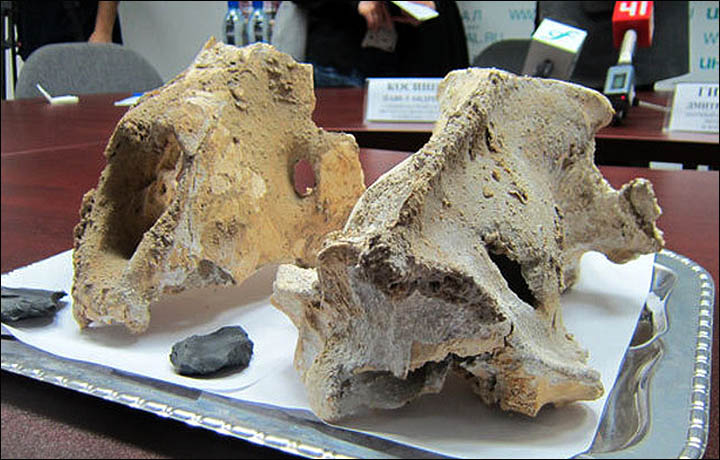
*This image is copyright of its original author
'We found about 500 bones and fragments of bones of the giant cave lion, and there can be more'. Picture: Pavel Kosintsev
The find was made in Imanai cave, in the Russian republic of Bashkiria, and it is causing excitement among Russian archeologists. In the excavation of a small area deep inside the cave, scientists discovered some 500 bones of giant cave lions - a unique discovery anywhere in the world.
They also found a cave bear skull pierced with an ancient spear. Weapons were also found - but no signs that pre-historic people lived in the cave.
Senior researcher Pavel Kosintsev, of the regional Institute of Plant and Animal Ecology, Urals Branch of the Russian Academy of Science, said: 'We found about 500 bones and fragments of bones of the giant cave lion. But there could be more, after we finish with sorting the collection.
'Such a large quantity of giant cave lion bones at one site is really unique, the only one in the world so far discovered.'
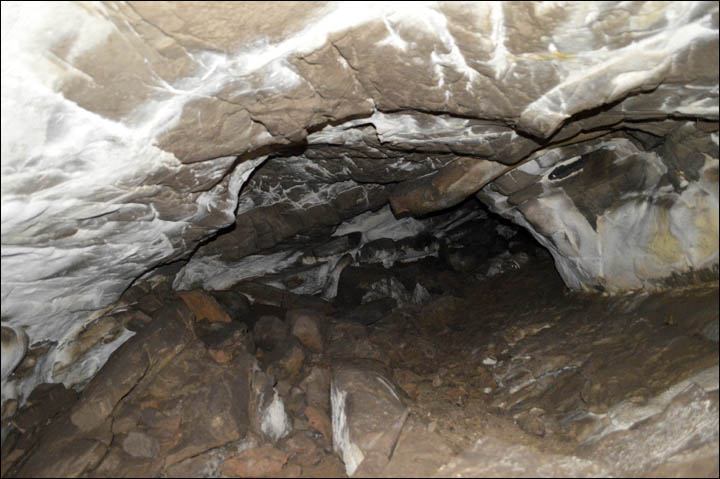
*This image is copyright of its original author
Imanai Cave, Republic of Bashkiria, Russia. Picture: Pavel Kosintsev
The experts believe they have found the remains of five or six of the extinct giant cave lions.
'Surprisingly, the bones were found in the depths of the cave, about 100 metres from the entrance,' he said. 'Usually lions did not go so deep into the cave, it is not typical for them'.
Previously archeologists have found isolated remains deep inside the caves, but these are believed to have been 'sick or injured lions, or lost cubs'. Mr Kosintsev believes the cave was 'an ancient sanctuary - and those lions could have been brought to the cave by ancient people'.
In other words, the cave had a religious significance to ancient man.
'Such cave sanctuaries were already found in the Czech Republic and Austria, which means we have some examples to compare.'
He said: 'There are other findings that can indicate it was a sanctuary. We also found the skull of a cave bear pierced with the spear, yet there were no evidence that ancient people hunted cave bears, at least not in the Urals.'
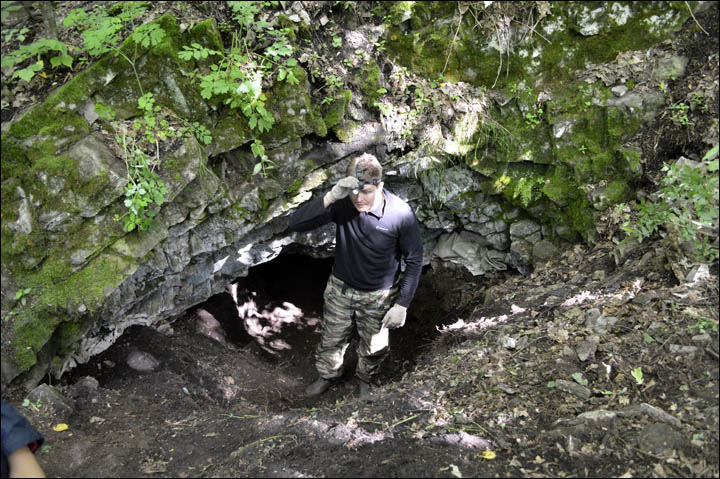
*This image is copyright of its original author
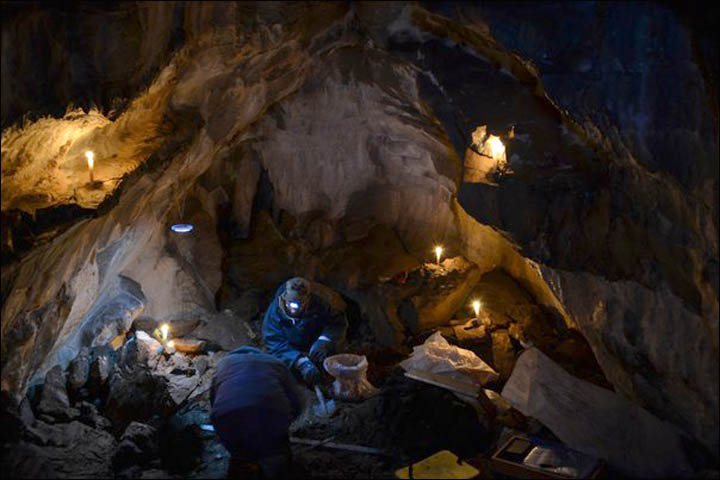
*This image is copyright of its original author

*This image is copyright of its original author
The cave had a religious significance to ancient men. Pictures: Pavel Kosintsev
The researchers also uncovered ten Mousterian stone spearheads. Previously only two had been located in the entire Urals region of Russia.
'The spearheads are the only sign of human activity - and it is also quite strange,' Mr Kosintsev said. 'If ancient people lived in this cave, they should have left the traces of making the spearheads, and bones of the animals which people ate. Here we see only the spearheads and it is further evidence in favour of the sanctuary hypothesis. People did not live here, they used this place for some other purposes, most likely, as a sanctuary.'
The latest finds have not been dated, but material collected in upper layers of the cave floor during a reconnaissance of the cave is around 30,000 years old.
The scientists remain optimistic of a treasure trove of future discoveries inside a cave that was first identified as a site of ancient man by hunters who noticed bones at the site. 'The recent findings, from the lower layers, can be older, up to 60,000 years ago. If we will get older data, it could be the world's most ancient sanctuary of this type. But of course we must wait for the exact data'.
The dating will be undertaken by Herzen State Pedagogical University in Saint Petersburg.
'We plan to continue the excavations next year, but the amount of finds we made this year is very large. There are about 20 sacks with ground and small fragments, and about 20 to 25 boxes with bones. We need to examine all this and I think that some significant updates may appear as soon as this year.'
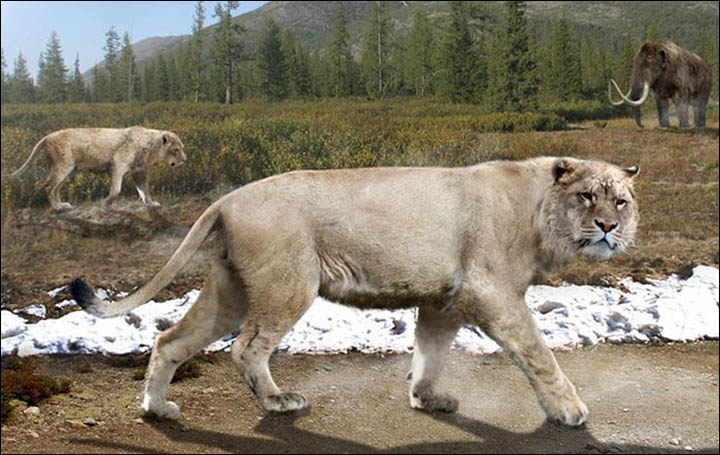
*This image is copyright of its original author
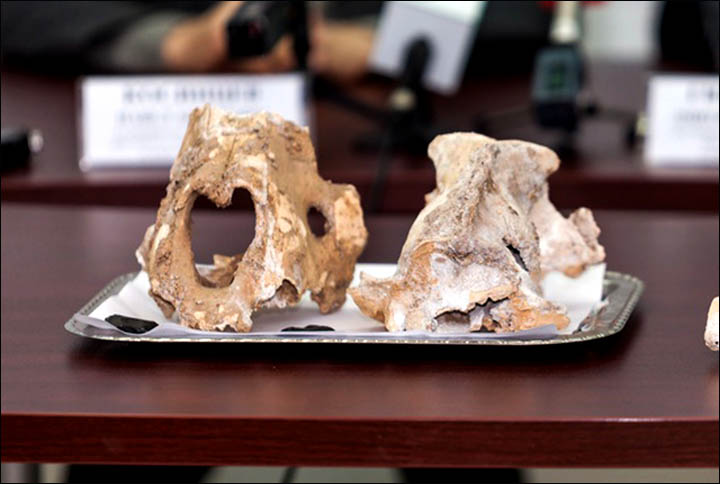
*This image is copyright of its original author
An artist impression of what cave lions looked liked, and bones found inside Imanai Cave. Pictures: Pavel Kosintsev
The finds were made in an area of six metres by six metres, to a depth of 60 cm, and it is hoped many more discoveries are waiting to be made.
The Mousterian period was a Stone Age era that lasted from about half a million to tens of thousands of years ago.
The weapons represent a 'very large collection', said scientist Dmitry Gimranov, who headed the excavation.
The giant cave lions found in the cave were 'at the peak of their ability'. This type of lion because extinct around 13,000 years ago. They were 25% bigger than today's African and had longer legs to chase their prey
http://siberiantimes.com/science/casestudy/features/f0144-worlds-greatest-ever-haul-of-supersize-cave-lion-bones-found-in-urals/
RE: Freak Felids - A Discussion of History's Largest Felines - GrizzlyClaws - 01-05-2016
@tigerluver, it seems that the Christiansen's equation could potentially underestimate an animal with relatively greater body mass but with slender limb bones.
In this case, it perfectly applies to the Panthera tigris species.